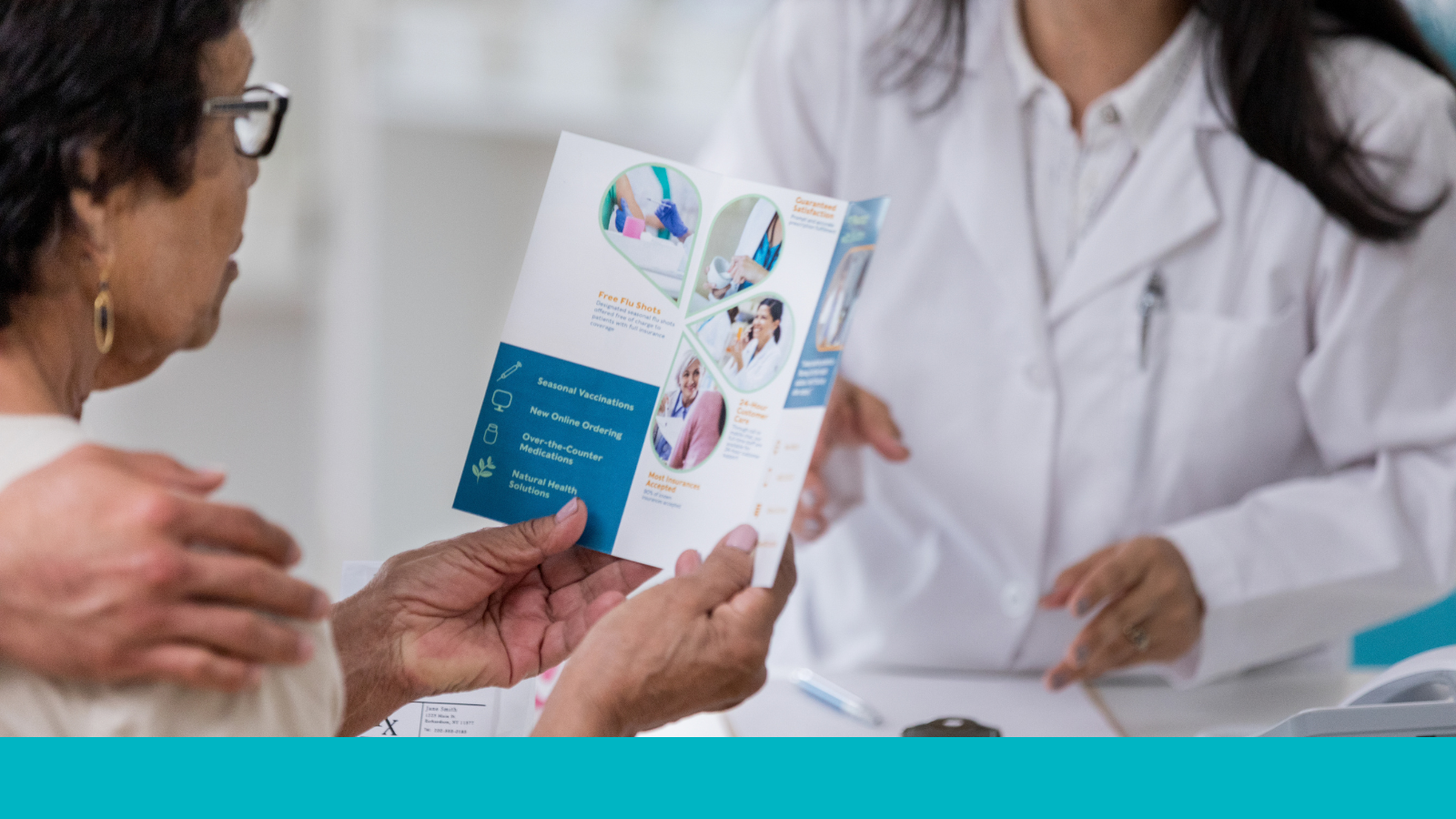Last Updated: December 3, 2025
A downloadable version of this communications guidance is available here.
Flu and COVID-19 vaccines updated for the 2025-26 season are now available in all US states, territories, and freely associated states. Use the key messages below to communicate about who should get these vaccines, how to access them, and why they’re essential for individual and community health.
Communicating About Flu and COVID-19 Vaccination in 2025-26 references guidance from medical associations, including the Infectious Diseases Society of America (IDSA), the American College of Obstetricians and Gynecologists (ACOG), and the American Academy of Pediatrics (AAP) as expert sources on flu and COVID-19 vaccinations.
Table of Contents
- Key Messages About the Flu Vaccine
- Key Messages About the COVID-19 Vaccine
- Vaccine Communication Best Practices
- Additional Sources
Key Messages About the Flu Vaccine
About the Flu and the Flu Vaccine
The flu, also called influenza, is a contagious respiratory illness caused by viruses that infect the nose, throat, and lungs. Flu symptoms can range from mild to severe and include fever, cough, sore throat, fatigue, chills, nausea, runny or stuffy nose, and head and body aches. The flu spreads at a high rate between November and April: the time of year often called flu season or respiratory virus season.
Each year, new variants of the flu emerge, and scientists work to develop a flu vaccine that offers the best possible protection against these new strains of the virus. During some periods, like the 2025-26 flu season, new variants emerge after the updated flu vaccine has been developed. In these instances, getting the updated flu vaccine remains the best way to prevent severe flu symptoms, hospitalization, and death.
Who Should Get the 2025-26 Flu Vaccine
- Everyone ages 6 months and older should get an updated flu shot, ideally in September or October, to protect against severe flu infection.
- Children between the ages of 6 months and 8 years should get two doses of the flu vaccine if this is their first time being vaccinated against the flu or if they have only ever received one dose. They should get the second dose four weeks after the first.
- People who live with or care for children, especially those younger than 6 months, should get a flu vaccine to help protect this high-risk group.
- People who are pregnant should get a flu vaccine to protect their babies and themselves from the flu. Pregnant people can get the flu vaccine at any time during their pregnancy, but it is best to get the vaccine early in the flu season (October through May). People who are pregnant and have a medical condition that increases their risk of flu complications should consider getting vaccinated before flu season begins.
Why the Flu Vaccine is Essential to Staying Healthy
The flu is highly contagious and potentially fatal. The 2024-25 flu season was particularly severe, leading to at least 47 million illnesses, 610,000 hospitalizations, and 26,000 deaths. At least 216 of those deaths were children, marking the deadliest non-pandemic flu season on record for children in the United States. The 2025-26 flu season is also projected to be severe, due to a fast-spreading variant of the flu virus and a decrease in flu vaccination in the United States over the past few years.
On average, 26.8 million Americans become infected with the flu every year. Seasonal flu vaccine effectiveness studies show that flu vaccination, on average, reduces the risk of serious illness by 40% to 60%.
Vaccines activate the body’s immune response against the flu virus, which can then protect people from severe respiratory illness. Vaccination is especially important and effective in the fall and winter when respiratory diseases circulate in high volume across the country.
When administered as advised by healthcare professionals, flu vaccines can prevent flu infection, reduce the severity and duration of flu symptoms and illness, and save the lives of adults and children.
Flu Vaccine Safety
Flu vaccines were developed through a rigorous scientific process over decades and have been thoroughly tested for their safety and benefits.
Though different vaccine types use different production technologies, all flu vaccines meet the FDA’s safety and efficacy requirements and can be used interchangeably by most people.
Some people report mild side effects after receiving their flu vaccine, such as headaches, muscle pain, fever, tiredness, and swelling at the injection site. Though side effects might occur, flu vaccines cannot cause flu illness.
Getting the Flu Vaccine: When, Where, and Other Considerations
When
People can get the vaccine at any time during flu season, but it is most effective when received before the flu begins to circulate in communities, which typically happens during the fall and winter. Protection may decrease over time, and flu activity typically peaks between December and February.
Public health departments and institutions recommend getting a flu vaccine every fall. This is because some viruses, like the flu, change rapidly. These changes mean people need to update their defenses against the virus more often than they do for other viruses.
Where
The flu vaccine is available at pharmacies, health clinics, and from healthcare professionals. People can typically book a vaccine appointment online or by contacting a local pharmacy, healthcare professional, or health department.
For the first time, FluMist, a self-administered nasal spray flu vaccine, is available for online order and home delivery. FluMist is FDA-approved for home use by adults ages 18 to 49 years. Caregivers of children can also administer FluMist to children ages 2 to 17. It is not recommended for pregnant people or people with certain underlying health conditions. Anyone who is interested in this at-home flu vaccination option should talk to a healthcare professional first.
Cost
For adults and children who HAVE insurance, the flu vaccine should be fully or mostly covered as preventive care. For adults and children who do NOT HAVE insurance, free or very low-cost flu vaccine options may be available, but they can be difficult to find. People should talk to a local pharmacist or a healthcare professional, or check with their local health department about their options.
What to Bring to the Appointment
Those with insurance should bring their insurance card.
People may also be asked to provide identification at their appointment. Ahead of time, contact a local pharmacist or healthcare professional and ask what forms of identification are acceptable.
Key Messages About the COVID-19 Vaccine
About COVID-19 and the COVID-19 Vaccine
COVID-19, also called coronavirus, is an infectious respiratory disease caused by the SARS-CoV-2 virus. COVID-19 symptoms can range from mild to severe and include fever, chills, cough, sore throat, shortness of breath, runny or stuffy nose, head or body aches, and new loss of taste or smell.
Each year, new variants of COVID-19 emerge. Scientists are continuously updating the COVID-19 vaccine to ensure it offers the best protection from these new strains of the virus.
Staying up to date with the latest COVID-19 vaccine is the most effective and safe way to prevent severe COVID-19 illness.
Who Should Get the 2025-26 COVID-19 Vaccine
Everyone ages 6 months and older should get the updated vaccine to protect against severe COVID-19 infection.
2025-26 COVID-19 Vaccine Recommendations for Specific Groups
- Children: AAP recommends that all children ages 6 to 23 months get the COVID-19 vaccine, along with children and teens ages 2 to 18 years who are at high risk for severe COVID-19.
- Children and teens ages 2 to 18 years who are not at high risk for severe COVID-19 can still get vaccinated this season for strong protection against COVID-19. Parents and other caregivers to children should talk to a healthcare professional about accessing the vaccine.
- Pregnant people: ACOG recommends that pregnant people receive an updated COVID-19 vaccine at any point during their pregnancy, when planning to become pregnant, in the postpartum period, or when lactating.
- Adults who are not at high risk for severe COVID-19: AAFP recommends that people ages 19-64 get one or more doses of the COVID-19 vaccine, and people ages 65 years and older get two or more doses. The COVID-19 vaccine dosage and type that’s best for a person is based on their vaccination history and other factors. People should talk to a healthcare professional about the COVID-19 vaccine that’s best for them this season, and where to access it.
Accessing the COVID-19 Vaccine
As of October 6, 2025, everyone ages 6 months and older should be able to access the COVID-19 vaccine from a physician, pharmacist, or other healthcare professional. According to the American Pharmacists Association, you should no longer need a prescription for the COVID-19 vaccine. However, you should check with your pharmacy or healthcare professional before scheduling a vaccine appointment, as policies may vary by state.
This season, the CDC recommends shared decision-making before a person can receive the vaccine. Shared decision-making, also known as individual decision-making, is a conversation between a patient and a healthcare professional to help inform treatment plans. Healthcare professionals include physicians and pharmacists.
Shared decision-making does not require booking an additional health appointment. These conversations can happen at the vaccine appointment.If you have medical insurance, the COVID-19 vaccine should be covered. If you do not have insurance, free or very low-cost vaccine options may be available. America’s Health Insurance Plans (AHIP) have pledged to cover the costs of vaccines approved by the CDC as of September 1, 2025 through the end of 2026. People should talk to a local pharmacist or their healthcare professional about their coverage options.
Why Getting an Updated COVID-19 Vaccine is Essential to Staying Healthy
COVID-19 continues to evolve and spread.
Each year, new variants of COVID-19 emerge. Updated vaccines are designed to provide protection against these new strains.
Most states saw an uptick in COVID-19 cases this summer, leading to the national wastewater viral activity for COVID-19 growing from “moderate” to “high” in September 2025. In addition, COVID-19 cases often surge during respiratory virus season, which spans November through April. Getting an updated vaccine helps ensure protection during times of increased spread.
Protection from the vaccine decreases over time.
Research suggests that the COVID-19 vaccine provides the strongest protection against COVID-19 during the first three months after vaccination and against severe disease for up to six months. Getting an updated COVID-19 vaccine helps provide the strongest protection against the virus over time.
COVID-19 Vaccine Safety and Effectiveness
As with all vaccines administered to the public, the COVID-19 vaccines have successfully met the following safety and effectiveness measures:
- Lab development
- Three phases of clinical trials
- Assessment of clinical trial results by the FDA
- Development and approval of vaccine recommendations through the Advisory Committee on Immunization Practices (ACIP) and CDC
Since the vaccines have been distributed, many systems continue to monitor and track outcomes from COVID-19 vaccines to ensure their safety and effectiveness.
Since 2020, more than 200 million people in the U.S. have safely received at least one dose of the COVID-19 vaccine. COVID-19 vaccines remain the most effective way to protect children, adults, and pregnant people from getting seriously ill, being hospitalized, and dying from COVID-19.
Getting an Updated COVID-19 Vaccine: First Steps and Other Considerations
First Step: Talk to a Healthcare Professional
The COVID-19 vaccine dosage and type that’s best for a person is dependent on their age, vaccination history, and other factors. People should talk to a healthcare professional about the COVID-19 vaccine that’s best for them this season, and where to access it.
Where to Get a COVID-19 Vaccine
Everyone ages 6 months and older should be able to access the COVID-19 vaccine from a healthcare professional, such as a pharmacist or physician.
What to Bring to the Appointment
Those with insurance should bring their insurance card.
People may also be asked to provide identification at their appointment. Ahead of time, contact a local pharmacist or healthcare professional and ask what forms of identification are acceptable.
Vaccine Communication Best Practices
Here are some suggestions and questions to consider when communicating about flu and COVID-19 vaccines.
Understand your audience.
- The more specific you can get about your audience, the more effective you can be in providing useful, relevant information. Answer the following:
- Which demographics have the highest or lowest vaccination rates? What messages and/or support do they need?
- What do I know about my community’s feelings about flu and/or COVID-19? How have perceptions changed in recent years and in relation to other public health issues?
- Where can I effectively communicate the various ways my community can protect themselves and others from severe respiratory illness this season?
Encourage people to make informed choices.
- By engaging without dictating, you can build trust in your community and increase their willingness to act on your message.
- Suggest that your community members seek guidance from their local health departments and healthcare professionals.
- Gather and share multiple and diverse trusted resources so people can find guidance that resonates with them.
- Balance positive, encouraging language with realistic, scientific language to clearly communicate the effectiveness of vaccines in preventing severe illness.
- Use consistent language. Vaccine, inoculation, and immunization have similar meanings. Select one to use throughout your communications.
Showcase the scientific rigor behind vaccines.
- In general, concerns about vaccines are often rooted in fear of the unknown and widely circulated misinformation about the approval process for vaccines. Discuss the details of vaccine development to bust myths while addressing FAQs.
- Share resources about how vaccines were developed from research to distribution.
- Create plain language and visually interesting illustrations of clinical trial reports, vaccine success, or other data that supports vaccines.
- Develop resources specifically for different age groups (e.g., older adults, college students, or parents with children of specific age groups) to explain what makes the vaccine safe.
Highlight vaccines’ ability to reduce disease spread and serious illness.
- Share plain language information on the safety and effectiveness of vaccines.
- Communicate about how flu and COVID-19 vaccines have reduced deaths and severe illness since they became available.
- Use social media content that educates followers about the benefits of vaccination.
- Highlight personal stories of vaccination that have impacted your community’s health.
Read our Communicating More Effectively About Vaccines guide for additional messaging guidance on this topic. You can also read our Plain Language for Public Health Checklist and Bridging Statements Guide for more tips on sharing effective, relevant, and accessible communications.
Additional Sources
Flu
- Flu | American Academy of Pediatrics
- Influenza | Infectious Diseases Society of America
- The Flu Vaccine and Pregnancy | The American College of Obstetricians and Gynecologists
COVID-19
- Coronavirus Disease (COVID-19): Symptoms & Treatment | Cleveland Clinic
- COVID-19 Vaccine Information | The American College of Obstetricians and Gynecologists
- COVID-19 Overview | American Academy of Pediatrics
- What to Know About COVID Vaccine This Fall | Verywell Health
- ACIP Evidence to Recommendations for Use of Moderna COVID-19 Vaccine in Children Ages 6 Months–5 Years and Pfizer-BioNTech COVID-19 Vaccine in Children Ages 6 Months–4 Years under an Emergency Use Authorization | U.S. Centers for Disease Control and Prevention



